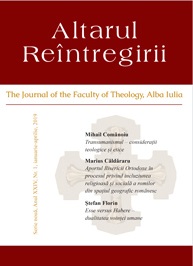Rânduiala înmormântării laicilor în Molitfelnicele slavo-române (sec. XVI-XVII)
The Office for the burial of a layman, according to the Slavo-Romanian Euchologia (16th-17th c.)
Author(s): Mihail Khalid QaramahSubject(s): Christian Theology and Religion, Theology and Religion, Pastoral Theology
Published by: Facultatea de Teologie Ortodoxă Alba Iulia
Keywords: funeral rite; Byzantine liturgical tradition; Trebnik; Peter Mohyla; prayer for the deceased;
Summary/Abstract: The purpose of this study is to offer a close insight about the development of the Office for the burial of a layman, as witnessed by several important liturgical manuscripts and printed editions of the Slavo-Romanian Euchologia dated to the 16th-17th c. and preserved at the Romanian Academy Library (BAR). These liturgical documents describe a distinct Office for the burial of a layman than the curent received formulary, some differences being the lack of a Canon, the distinct selection of hymnography, the insertion of the first stasis of the anabathmoi of each tone and the use of different prayers of absolution for the deceased. The author concludes that there was a strong monastic influence on the redactive process of the Office for the deceased layman, that in the 17th c., the Euchologion printed at Câmpulung in 1635 contributed to reaching a certain degree of uniformity in the Romanian liturgical practice, and that the Trebnik of Peter Mohyla (1646) also influenced the local liturgical usage.
Journal: Altarul Reîntregirii
- Issue Year: XXVI/2021
- Issue No: 1
- Page Range: 131-164
- Page Count: 34
- Language: Romanian

